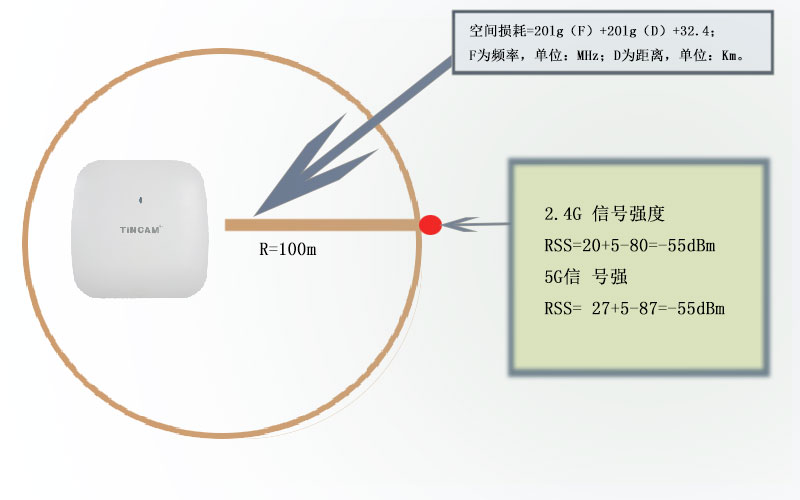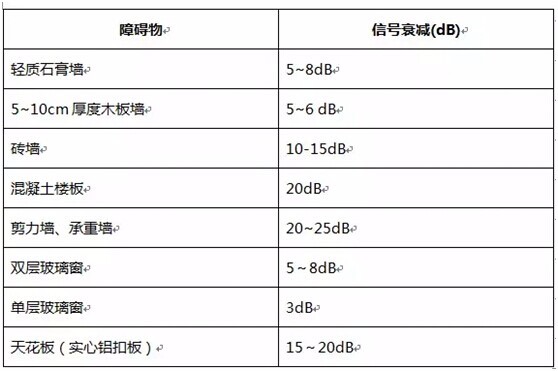WiFi is already a hot "net red", but it doesn't matter how much the user knows about the WiFi signal strength and coverage distance.
We often come across users asking: How wide or how far can your wireless AP cover? The customer's understanding of this problem is very simple, but from a professional point of view, it makes us very headache, and it is very troublesome to answer.
Before we do that, let's take a look at how signal strength is measured.
Wireless signal strength = transmitted signal strength - intermediate attenuation
The transmission medium used by WiFi is an electromagnetic wave in the frequency band of 2.4 GHz or 5.8 GHz. According to the characteristics of electromagnetic wave transmission, the free space attenuation of electromagnetic wave can be calculated by the formula:
Space loss = 20lg (F) + 20lg (D) + 32.4; F is frequency, unit: MHz; D is distance, unit: Km.
It can be seen from this formula that the higher the frequency, the greater the loss.
From this we can calculate the signal strength of an AP covering a distance of 100 meters:
Take a Shenzhen Tianbo TBC-300BPAD indoor 802.11ac AP as an example. The AP has a transmit power of 20dBm at 2.4GHz, a power of 27dBm at 5.8GHz, and an antenna gain of 5dBi. The signal is in a completely empty area. Transmission 100 meters;

The result is clear. Our indoor APs, whether 2.4 GHz or 5.8 GHz, cover 100 meters in a completely open area without any problems.
Then, can we design according to the standard of each indoor AP covering a radius of 100 meters? Of course not, because the above attenuation model is based on free space attenuation (completely empty, no obstacle obstruction environment), there are many obstacles in the actual project environment, and other influencing factors.
In fact, the range and distance of wireless AP signal coverage depends more on factors other than wireless APs. The capabilities and performance of wireless APs can only be considered as one of the influencing factors.
1 Wireless AP and wireless client environment
This factor is better understood, because WiFi uses the wireless microwave frequency band, the microwave is characterized by near-linear propagation, and the diffraction ability is very weak, so the wall, decoration, furniture, ceiling, etc. in the WiFi coverage environment will cause additional signals. attenuation. In addition, a series of complex changes such as reflection, diffraction, and refraction occur.
The following are the effects of various obstacles on the signal:

Speaking of this, it is not difficult to understand why the necessary work when answering the customer's question is to remind the customer: we need to understand the actual environment before we can draw a preliminary conclusion.
2 environmental changes
The universe is evolving in constant change. Our environment is always changing. Objects and people move, the humidity in the air rises, and even electromagnetic radiation from space affects the transmission of wireless signals.
Give some examples of life:
For example, the barrier effect of brick walls, partition walls and concrete walls on wireless signals is very large. It is also a concrete wall. There are steel bars and no steel bars, and there are many and few steel bars. The signal penetration effect is different. So the same is a wireless AP, why this is good, that is generally, this problem is well understood.
3 client wireless network card capabilities
Experienced wireless network users will find that the same WiFi signal in the same location, the signal strength of the notebook is often stronger than the mobile phone, mainly because of the different wireless network card and antenna receiving capabilities of the terminal device. This is why, in the same location, this mobile phone is fast, and the mobile phone is slow.
Finally, there is a question about mathematical and physics. In simple terms, the farther away the signal is, the worse the signal is, and the lower the transmission rate is.
For example, if you watch the video, you may need to be within 15 meters of the wireless AP. If you just open the web page to watch the news and brush the circle of friends, it may be no problem 50 meters away from the wireless AP.
Return to the original question: How wide can wireless APs cover? How far can it be?
Can only answer: This wireless AP can transmit one voice and one video at about 100 meters in an open environment, but the actual use needs to be converted according to the environment.
5S180series the pump is mainly used for water injection and high pressure conveying medium. In 1986, the company introduced the technology of Electric Pump manufacturing. It has first-class manufacturing and testing equipment, and has the service ability of offshore and land production equipment. And our company has completed a complete R & D, production, maintenance, equipment system and service team.
Reciprocating Plunger Pump 5S180series
Triplex Plunger Pump,High Pressure Reciprocating Plunger Pump,Pressure Reciprocating Plunger Pump,Hydraulic Triplex Vane Pump
Tianjin RongHeng Group LLC , https://www.wholesale-water-pump.com